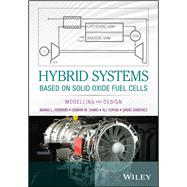A comprehensive guide to the modelling and design of solid oxide fuel cell hybrid power plants
This book explores all technical aspects of solid oxide fuel cell (SOFC) hybrid systems and proposes solutions to a range of technical problems that can arise from component integration. Following a general introduction to the state-of-the-art in SOFC hybrid systems, the authors focus on fuel cell technology, including the components required to operate with standard fuels. Micro-gas turbine (mGT) technology for hybrid systems is discussed, with special attention given to issues related to the coupling of SOFCs with mGTs. Throughout the book emphasis is placed on dynamic issues, including control systems used to avoid risk conditions.
With an eye to mitigating the high costs and risks incurred with the building and use of prototype hybrid systems, the authors demonstrate a proven, economically feasible approach to obtaining important experimental results using simplified plants that simulate both generic and detailed system-level behaviour using emulators. Computational models and experimental plants are developed to support the analysis of SOFC hybrid systems, including models appropriate for design, development and performance analysis at both component and system levels.
- Presents models for a range of size units, technology variations, unit coupling dynamics and start-up and shutdown behaviours
- Focuses on SOFCs integration with mGTs in light of key constraints and risk avoidance issues under steady-state conditions and during transient operations
- Identifies interaction and coupling problems within the GT/SOFC environment, including exergy analysis and optimization
- Demonstrates an economical approach to obtaining important experimental results while avoiding high-cost components and risk conditions
- Presents analytical/computational and experimental tools for the efficient design and development of hardware and software systems
Hybrid Systems Based on Solid Oxide Fuel Cells: Modelling and Design is a valuable resource for researchers and practicing engineers involved in fuel cell fundamentals, design and development. It is also an excellent reference for academic researchers and advanced-level students exploring fuel cell technology.









